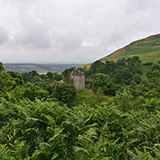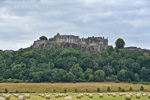History
Castle Campbell is a medieval castle overlooking Dollar Glen in central Scotland. It was the Lowland seat of the powerful Clan Campbell and the Dukes of Argyll, and played a key role in Scottish history from the 15th to the 19th century. The natural defended position may have been the site of a 12th century motte. The present Tower House style castle was built around 1430 for John Stewart, Lord Lorne, or one of his kinsmen, and was known as Castle Gloom.

Around 1460, during his marriage to Isabel Stewart, daughter of Lord Lorne, the castle was acquired by Colin Campbell, 1st Earl of Argyll. A year later, the first historical record of the castle appears when Pope Paul II issued a bull (public decree) against Walter Stewart for attacking and damaging the "Place of Glom".
Castle Gloom expanded the power of the Campbell family. It made it easier for Colin Campbell, who was the Master of the Household to King James III of Scotland, who required his frequent presence at court at nearby Stirling Castle.
In 1489, Colin changed the name of the castle to Castle Campbell, a name approved by James IV and an act of parliament in the Castle Campbell Act of 1489. At the time, Castle Campbell consisted of the Tower House along with other buildings arranged around the courtyard and gardens. The East Range was likely added first, and sometime after the accession of the 2nd Earl of Argyll in 1493, the South Range was begun.
In 1513, Archibald Campbell, 2nd Earl of Argyll, was killed at the Battle of Flodden Field.
In the 16th century, Archibald Campbell, 4th Earl of Argyll, supported the Scottish Reformation and became one of the leading Protestant lords of the time. His family supported John Knox, leader of the Reformation, while he was in Scotland in the 1550s. Sometime after 1556, Knox visited Castle Campbell and preached there. the 4th Earl also took part in the Battle of Pinkie in 1547 and in the sieg of Haddington in 1548.
In January of 1563, Mary, Queen of Scots, stayed at the castle for three days to attend the marriage of Margaret, sister of the 5th Earl of Argyll, and James Stewart, Lord Doune.
It is said that the Earl of Argyll and James Stewart, 1st Earl of Moray, plotted to capture Queen Mary and Lord Darnley as they returned to Edinburgh from Perth, to prevent their marriage. Mary was to be imprisoned in Lochleven Castle or St. Andrews Castle, while Darnley would be taken to Castle Campbell.
In 1565, following the marriage of Mary and Darnley, Argyll joined Protestant lords in the rebellion known as the Chaseabout Raid over Queen Mary's marriage to Darnley. The Queen's forces ended this rebellion, which resulted in Mary and Darnley receiving the surrender of Castle Campbell.
In the 1590s, Archibald Campbell, 7th Earl of Argyll, rebuilt the East Range to link the South Range with guest chambers in the Tower, which included a two-arched covered corridor facing the courtyard. The East Range has been compared to the north courtyard façade of Crichton Castle, which was constructed around the same time.
In 1590, James IV of Scotland was displeased with Alexander Menteith, captain of Castle Campbell, who had released Henry Mersair, who was found guilty of fire-raising, murder, slaughter, and other crimes. Agnes Douglas, Countess of Argyll, imprisoned Thomas Alexander of Balruidy at Castle Campbell after claiming he was a sheep rustler.
In the mid-17th century, the Earls of Argyll continued to support the Protestant cause, and Archibald Campbell, 8th Earl of Argyll, became the leader of the Presbyterian Covenanters, opposing the leading Royalist, James Graham, 1st Marquess of Montrose. In 1645, Montrose's troops laid waste to the lands around Castle Campbell, including Dollar and Muckhart, on their way to the Battle of Kilsyth. The castle was undamaged. In response, the Earl of Argyll ordered the destruction of Menstrie Castle and Airthrie Castle, both Royalist strongholds. The 8th Earl of Argyll also fought in the Battle of Kilsyth, from which he escaped to Newcastle in 1645.
After the execution of King Charles I, the Campbells supported Charles II, with the Earl of Argyll placing the crown of Scotland on Charles' head at Scone in 1651. However, when Charles II invaded England, Argyll opposed him and submitted to Oliver Cromwell's Commonwealth in 1652. Cromwell's forces were garrisoned at Castle Campbell in 1653. In July of 1654, Royalist rebels attacked and burned the castle over two nights.
After the Restoration of 1660, the Earl of Argyll was executed. His son, the 9th Earl of Argyll, chose to build Argyll's lodging at Stirling Castle instead of restoring Castle Campbell. The castle was left abandoned, except for brief periods of garrisoning during the Jacobite Rising of 1715.
In 1805, the 6th Duke of Argyll sold Castle Campbell to Crauford Tait, who owned the estate of Harviestoun, next to the castle. In 1859, they were both purchased by Sir Andrew Orr, the former Lord Provost of Glasgow.
In 1948, the owners of Harviestoun donated Dollar Glen and Castle Campbell to the National Trust of Scotland, which arranged for the castle to be cared for by the Ministry of Works. The Ministry of Works added a new roof to the Tower House. Castle Campbell is now in the care of Historic Environment Scotland.
Castle Highlights
Castle Campbell, one of Scotland's best preserved Tower Houses, stands alone upon a ridge overlooked by the Ochil Hills, flanked by steep ravines on either side of the castle, through which pass the Burn of Care and the Burn of Sorrow.
The castle features a 20-meter-tall Tower House, surrounded by a courtyard, with curtain walls and terraced gardens. The four-story Tower House has vaulted ceilings and parapets, offering panoramic views over Dollar Glen and the Vale of Devon. John Knox's Pulpit, in the garden, marks where the preacher delivered sermons.
The Tower House had a storage cellar and prison on the ground floor and a hall on the first floor. Private chambers were located on the top two floors.
Across the courtyard was a two-story range, which included a great hall, a withdrawing chamber, and a court kitchen on the first floor, with vaulted storerooms on the ground floor.
Other nearby castles worth exploring include Stirling Castle, Doune Castle, Clackmannan Tower, and Alloa Tower.





